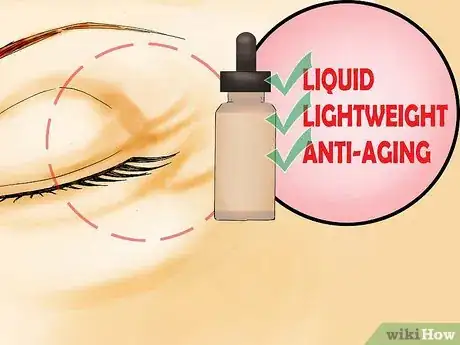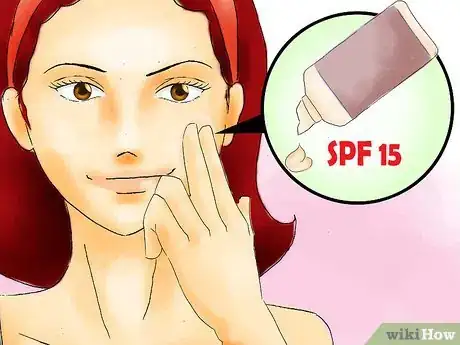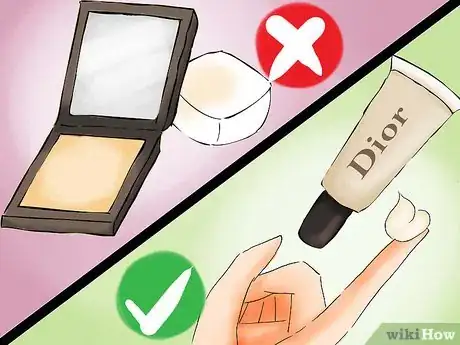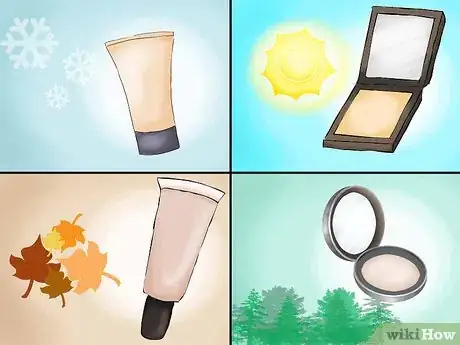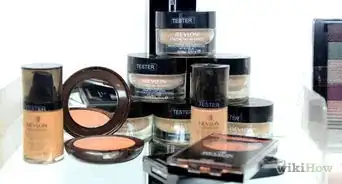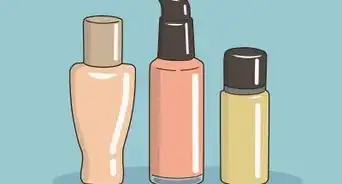This article was co-authored by Melissa Jannes. Melissa Jannes is a Licensed Esthetician and the owner of Maebee's Beauty Studio in Philadelphia, a single practitioner space providing quality services with individualized attention. Melissa is also a National Educator for Universal Companies. She received her esthetics degree at The Beauty School of Middletown in 2008 and is licensed in both New York and Pennsylvania. Melissa won the "Best of Beauty" award from Allure magazine in 2012 for the quality of her bikini waxing.
There are 21 references cited in this article, which can be found at the bottom of the page.
wikiHow marks an article as reader-approved once it receives enough positive feedback. In this case, 82% of readers who voted found the article helpful, earning it our reader-approved status.
This article has been viewed 339,740 times.
There are thousands of foundations out there for every look imaginable. While this means you have a lot of options, it can be overwhelming if you’re a makeup beginner or if you're trying to pick a new product. Thinking about the type of skin you have and what you want the foundation to do for you can help you find the perfect foundation for you. Your foundation can be good for your skin and help it look its best.
Steps
Choosing a Foundation for Your Skin Type
-
1Use oil-free foundations for skin that is prone to breakouts. A foundation that is thick or has a lot of moisturizer can make your oily skin oilier. Stay away from heavy pancake foundations that can clog pores. Instead, choose a foundation that is lightweight and won't cause breakouts. Look for a foundation with salicylic acid like Clinique's line of foundations for acne prone skin; these formulas can actually reduce or even prevent breakouts.[1]
-
2Avoid foundations that can irritate sensitive skin. If your skin reacts to certain cleansers or moisturizers, you may find the same problem with some foundations. Many cosmetic companies, such as Cover Girl and Lancome, have a line of hypoallergenic or noncomedogenic and fragrance free foundations designed for sensitive skin.Advertisement
-
3Prevent and reduce signs of aging for mature skin. You probably want to stay away from powder based foundations and heavy matte foundations. These can settle into lines on your face and make you look older. Try lightweight liquid foundations with moderate coverage. Also, look for foundations that can protect your skin from further aging as well as improve your skin’s appearance now.[2]
-
4Choose a foundation with SPF. While foundations that have an SPF rating are more and more common, many foundations have no sun protection at all, so be sure to check. Makeup lines for sensitive skin often have good sun protection, so those may be a good place to find the foundation you need. Look for a foundation with an SPF of at least 15. Use a good sun screen as well to get the full protection your skin needs.[3]
-
5Use a moisturizing foundation for dry skin. Liquid foundations are probably the best choice for you. Some mineral based powder foundations can nourish your skin too, but typically powder foundations aren't the best choice for dry skin. Department store lines like Dior as well as drugstore cosmetic brands like L'Oreal make rich creamy foundations that work well for dry skin.[4]
-
6Keep normal skin healthy with a lightweight foundation. If you don't typically have any problems with excessively oily or dry skin, a sheer liquid foundation or tinted moisturizer will even out your skin tone and conceal minor skin flaws.[5]
Complementing Your Complexion and Coloring
-
1Figure out your skin's undertone. Undertone is not the same as skin color or tone; your skin tone can change, but your undertone does not. Undertones can be cool, warm, or neutral. In addition to pigment or color, foundations have a cool, warm, or neutral tone as well. In order for your makeup to blend seamlessly with your coloring, it needs to work with your specific undertone.[6]
- If you have a rosy or pinkish complexion, or a yellow or golden tint, your undertone is warm.
- Blue or purple tints, as well as olive or greenish hues, mean you have a cool undertone.
- If you don't see a definite tint in one direction or the other, then you probably have a neutral undertone.
- Check the veins in your wrist or ankle for clues about your undertone. Veins that look purplish bluish indicate a cool undertone. Veins with a faint green coloring suggest a warm undertone.
-
2Look at your wardrobe and accessories. You probably already make choices in clothing or jewelry that suit your undertone, so think about the colors that look best on you in order to figure out whether you have a warm, cool, or neutral undertone.
- If you typically favor silver toned jewelry, your undertone is likely warm.
- Gold tone jewelry works best with cool undertones, so if you gravitate towards gold, you probably have a cool undertone.
- If you can wear either gold or silver toned jewelry, you have a neutral undertone.
- Do you look your best in warm colors like red, yellow, or orange? Then your undertone is probably cool.
- Warm undertones look best in cool colors like blue, green and purple.
-
3Match the shade of foundation to your undertone. Foundations mainly come in three ranges of shades: fair, medium, and dark. For each range of shades there is also a range of undertones: cool, warm, and neutral. You want to find the right shade with the right undertone. For instance, very light blondes with pale skin that burns easily often look best with a fair shade of foundation that has a yellow or golden undertone.[7]
-
4Take into consideration your hair color. Your foundation should look natural and complement your look overall. If you have recently changed your hair color, or if your hair has greyed significantly, you need to recalibrate your foundation to suit your new look.
- For lighter hair color, a foundation with some warmth can keep you from looking too pale or washed out.
- A lighter, cooler foundation often contrasts well with darker hair.
- Redheads should typically avoid foundations with too many pink or rosy tones.
Testing Different Foundations
-
1Test out several foundation shades before buying. Foundations can look very different in the bottle as opposed to on your skin. Makeup counters at most department stores will let you try out different foundations, so a trip to a cosmetics counter is worth your time and effort if you want to avoid making a mistake about the best shade for your skin.
- A department store will have multiple lines of cosmetics, making it easier for you to select the right foundation for your skin type and your makeup needs.
- Typically the people working at makeup counters are very knowledgeable about a variety of cosmetic lines, and they can help you narrow down your best options.
- Even if you don’t want to pay department store prices, you can find a good match for your skin there and then find a less expensive brand that is a close or even identical match.
EXPERT TIPMelissa Jannes is a Licensed Esthetician and the owner of Maebee's Beauty Studio in Philadelphia, a single practitioner space providing quality services with individualized attention. Melissa is also a National Educator for Universal Companies. She received her esthetics degree at The Beauty School of Middletown in 2008 and is licensed in both New York and Pennsylvania. Melissa won the "Best of Beauty" award from Allure magazine in 2012 for the quality of her bikini waxing.Licensed Esthetician
 Melissa Jannes
Melissa Jannes
Licensed EstheticianOur Expert Agrees: A lot of times, foundations will oxidize, or change color when they're exposed to the air. That's why it's a good idea to visit a store like Sephora or Ulta where you can try on the foundation first to see how it wears before you buy it.
-
2Make an appointment with a makeup artist. Some types of foundation need special application tools or techniques for optimal coverage and wear, or may take more time and maintenance than you would like. A makeup artist can give you advice and tips about the best foundation for your needs.[8]
- Tell the makeup artist about any skin allergies or sensitivities.
- Bring a few magazine ads or pictures with you to show them the kind of look you want to achieve.
- Ask the makeup artist about any special brushes or applicators that you need to use with a foundation.
- Ask for any tips or tricks about applying foundation.
- Discuss your morning and evening routine and how much time you typically spend applying and removing makeup.
- Find out what makeup remover or cleansing products work best for specific foundations types.
-
3Try out different shades on your own. If you only have time for a quick shopping trip, you can sample foundations from different cosmetic counters yourself. There are different options, and different opinions, about where you should try out foundation shades. While the most obvious choice is your cheek or jawline, if you are wearing makeup already you may need to test the foundation somewhere else on your body.
- If you have avoided over-exposure to sun, your chest is a good option for selecting the best shade of foundation.[9]
- The jawline is probably one of the most common areas for testing foundation colors. This is a particularly good way to make sure that your foundation matches with the skin on your neck.[10]
- The skin on your arm or hands is not a good place for testing foundation colors. The skin on your face is very different in texture than that on your arm or hand, and probably very different in color as well.
-
4Try a few colors at once. Apply a couple of colors to the jawline of your left check and a couple more to the right side of your cheek. Looking at several shades at one time will help you compare the look and feel of different products.[11]
-
5See how you look in natural light. The fluorescent lights in most department stores can alter how foundation colors look on your skin. Once you have found a color that seems to match your skin, apply a larger amount to your face. Step outside with a mirror and check your reflection in natural light to make sure it still looks right for you.[12]EXPERT TIPMelissa Jannes is a Licensed Esthetician and the owner of Maebee's Beauty Studio in Philadelphia, a single practitioner space providing quality services with individualized attention. Melissa is also a National Educator for Universal Companies. She received her esthetics degree at The Beauty School of Middletown in 2008 and is licensed in both New York and Pennsylvania. Melissa won the "Best of Beauty" award from Allure magazine in 2012 for the quality of her bikini waxing.Licensed Esthetician

 Melissa Jannes
Melissa Jannes
Licensed EstheticianIf you get home and your foundation doesn't match your skin, take it back for a refund. If you do buy a foundation that's the wrong color, you can take it back to the store and return it as long as you have a receipt.
-
6Ask for a second opinion. Bring a friend to help you choose which foundation suits you best. You can always ask for feedback from the makeup professionals manning the counters of course, but sometimes the best advice comes from someone who knows you really well.
Getting the Look You Want
-
1Have a clear idea of the look you want. Foundation can make or break a look, so you want to choose a one that will work for your style and your needs. You can use foundation to get anything from a nearly naked skin look to a flawlessly smooth matte finish.[13]
- For a luminous glow, choose a lightweight water based liquid foundation. Apply sparingly to skin. Finish the look with a pressed powder that has a little sparkle. You can also skip the powder and instead try spritzing your finished face with mineral water for an extra glow.
- A dewy face looks healthy and fresh. Make sure you choose a foundation that has a moisturizer in it and is oil based rather than water based.
- You can get a matte finish from several different forms of foundation: a matte liquid, a mousse, or a matte powder. You want to make sure your skin is oil free before and during applying the foundation, so start with a very clean face and try using a primer base. Use a brush or sponge to apply the makeup so that you don't get oil from your fingers on your face.
-
2Keep in mind your environment as well as your plans. For instance, if your plans include physical exertion or humid conditions, a foundation that is water-resistant or sweat-resistant but still breathable would be appropriate. If you're attending a formal event, a foundation that has staying power but has shine control will help you look your best in photographs.[14]
- If you're heading for the gym or the tennis court, a sweat-proof foundation that isn’t too heavy and won’t clog pores, with an SPF of at least 20, is a good choice.[15]
- If you are selecting a foundation for work or school, avoid going too cool in tone. The fluorescent lighting in most buildings can make you look pale, so adding a little warmth can compensate.[16]
- For proms, formal events, or weddings, choose a foundation that won't fade and will keep your skin looking picture perfect. A semi-matte to matte foundation is a great option because these foundations are usually long-lasting and cut down on shine.[17]
- If you are typically in and out all day, or in natural light most of the time, look for a sheer foundation that won't make you look too "made-up.” Water based liquid foundations or a tinted moisturizer are good choices for you.
-
3Don't wear the same foundation color year round. You should change your foundation several times a year in order to match your coloring and adjust your look to the season. For example, if you tan during the summer, you should adjust your foundation to fit your new skin tone.[18]
-
4Mix colors for a perfect match. Your skin is unique and you may not find one shade that works. Try mixing colors or tones to create the perfect shade for you.[19]
-
5Dilute a heavy foundation with moisturizer. If you find a great match but don't like how it feels on your skin, you can probably make it feel lighter just by adding a few drops of moisturizer. Experiment with the ratio of moisturizer to foundation until you get a good balance of texture and coverage.
-
6Pick a foundation made for your age. Your skin’s texture and complexion changes as you get older, as do the skin problems you may want to address. Different formulations and types of foundation can make you look your best as well as take care of your skin as it ages.[20]
- For teens and early twenties, oily skin and breakouts can be an issue. Choose a water based foundation or a light mineral powder foundation. Use clean brushes or makeup sponges, and wash your hands before applying the foundation.[21]
- Your skin may begin to show signs of aging in your thirties and forties, so choose a foundation that will nourish your skin and keep it looking and feeling youthful as well. A cream foundation with an oil based moisturizer is a good choice, such as L'Oreal or Maybelline cream foundations.[22]
- As skin ages, look for a foundation that not only hides the signs of aging, but can help repair and revitalize your skin too. L'Oreal makes foundations with silicone to soften the appearance of fine lines, while Estee Lauder's foundations have anti-aging properties that may help slow down or prevent new lines from forming.
- Foundation for older skin should be lightweight and moisturizing. Stay away from powders that can cake in skin creases and make you look older.
Community Q&A
-
QuestionMy daughter has tried many foundations, but they all look very greasy to me. She's trying to hide her bad skin, but I wish I could find the perfect one for her.
 Cecilia FloresTop AnswererIf you're willing to invest some money, head to Sephora. They have a color matcher that will show your skin tone and show you what you would wear in every foundation, bb cream, and concealer the store sells. From there, you can pick one that would go with your skin type. Make sure you get a setting powder to set everything in. Some more tips: Try not to get a dewy foundation finish if you have oily skin. You can invest in a toner that will even out her skin. If she has any unevenness she doesn't like, she can try color correcting.
Cecilia FloresTop AnswererIf you're willing to invest some money, head to Sephora. They have a color matcher that will show your skin tone and show you what you would wear in every foundation, bb cream, and concealer the store sells. From there, you can pick one that would go with your skin type. Make sure you get a setting powder to set everything in. Some more tips: Try not to get a dewy foundation finish if you have oily skin. You can invest in a toner that will even out her skin. If she has any unevenness she doesn't like, she can try color correcting. -
QuestionWhat is a good moisturizer?
 Community AnswerIt depends largely on your own skin and preferences/needs. For the most part, moisturizers from higher-end brands, such as those sold at Sephora and Ulta, are much more effective than drug store moisturizers - and the employees at those stores can help guide you toward the right one for your skin. However, there are some good drug store options as well. CeraVe is a very good, affordable brand that even many dermatologists use and recommend.
Community AnswerIt depends largely on your own skin and preferences/needs. For the most part, moisturizers from higher-end brands, such as those sold at Sephora and Ulta, are much more effective than drug store moisturizers - and the employees at those stores can help guide you toward the right one for your skin. However, there are some good drug store options as well. CeraVe is a very good, affordable brand that even many dermatologists use and recommend. -
QuestionCan I wear a smooth foundation and set it with powder to make it look matte?
 Community AnswerYes, but it would be easier for you to just buy a matte foundation.
Community AnswerYes, but it would be easier for you to just buy a matte foundation.
References
- ↑ http://www.allure.com/gallery/best-foundations-for-acne-prone-skin
- ↑ http://40plusstyle.com/what-is-the-best-foundation-for-mature-skin/
- ↑ http://www.webmd.com/beauty/sun/sunscreen-and-your-makeup-routine
- ↑ http://www.webmd.com/beauty/makeup/make-your-makeup-last-dry-skin
- ↑ http://www.brit.co/find-the-right-foundation/
- ↑ https://www.beautylish.com/a/vxirv/how-to-find-your-undertone
- ↑ http://www.instyle.com/beauty/steal-base-celebrity-makeup-artists-reveal-best-foundations-every-skintone#418309
- ↑ http://www.besthealthmag.ca/best-looks/makeup/tips-for-getting-your-makeup-professionally-done/
- ↑ https://laurenconrad.com/blog/2015/03/beauty-beginners-how-to-find-the-right-foundation/
- ↑ http://www.cosmopolitan.com/style-beauty/beauty/advice/g2414/best-foundation-for-your-skin-tone/?slide=1
- ↑ http://www.prevention.com/beauty/makeup-how/how-choose-and-apply-foundation
- ↑ http://www.prevention.com/beauty/makeup-how/how-choose-and-apply-foundation
- ↑ http://fashionmagazine.com/beauty/skin-finish-fixes/
- ↑ http://www.fitnessmagazine.com/beauty/makeup/makeup-foundation-tips/?page=2
- ↑ http://www.youbeauty.com/beauty/sweat-proof-makeup/
- ↑ http://www.marieclaire.com/beauty/news/a12960/best-office-makeup/
- ↑ http://www.xovain.com/makeup/how-to-do-your-makeup-for-a-black-tie-formal-wedding
- ↑ http://www.goodhousekeeping.com/beauty/makeup/tips/a32285/common-foundation-mistakes/
- ↑ https://www.makeupgeek.com/content/makeup-basics/beauty-bite-color-match-foundation/
- ↑ http://www.harpersbazaar.com/beauty/skin-care/a12055/gorgeous-skin-at-every-age-1015/
- ↑ http://teens.webmd.com/girls/features/makeup-foundation-teenage-skin
- ↑ http://www.oprah.com/style/How-to-Choose-and-Use-the-Right-Foundation
About This Article
If you’re wondering how to pick the right foundation, choose one that suits your skin tone and the look you’re going for. For instance, if your skin has a cool undertone, with a blueish or olive tint in your veins, choose a cool tone foundation to complement it. If you have a pinkish or yellowish complexion, you should opt for a warm tone foundation instead. You can also choose your foundation based on the look you want to achieve. For example, use a water-based foundation to create a luminous appearance, or a mousse or matte powder for a matte finish. For tips from our Beauty co-author on how to complement your foundation with your clothes and accessories, keep reading!


